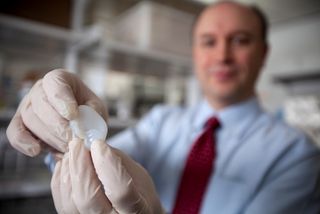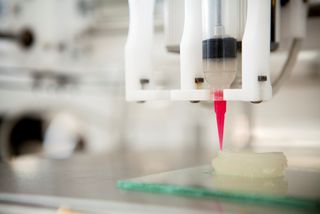3D-Printed Ear Created in Lab

With 3D printing, it seems the things you can make are limited only by your imagination. The latest innovation: a 3D-printed artificial ear.
The ear, which looks and functions like a normal human ear, was created by squirting living cells into an injection mold. Over the course of three months, each ear grew cartilage in the shape of its mold. These ersatz ears could replace the ears of children with congenital deformities, researchers report online today (Feb. 20) in the journal PLOS ONE.
"A bioengineered ear replacement like this would also help individuals who have lost part or all of their external ear in an accident or from cancer," co-lead author Jason Spector, a plastic surgeon at Weill Cornell Medical College in New York City, said in a statement. If the ears prove safe and successful, it could be possible to implant one in a human in as few as three years, Spector said.
Children with a deformity called microtia have an intact inner ear but an external ear that fails to develop fully, causing hearing loss. The prevalence ranges from slightly fewer than one to as many as four babies per 10,000 births, depending on the country. [The 9 Most Bizarre Medical Conditions]
The artificial ears were made by producing a digital 3D image of a child's intact ear and feeding that into a 3D printer to produce an ear-shaped mold. Then the scientists injected a gel made of living cow ear cells and collagen (a substance used to make gelatin) into the mold, and out popped an ear.

The whole process took less than two days: half a day to design the mold, a day to print it, half an hour to inject the gel, and 15 minutes to allow it to set.
Then the researchers implanted the fabricated ears on the backs of rats, where the ears grew for one to three months. Creepy as it sounds, it isn't the first time scientists have grown ears on rodents, as a model for naturally growing ears.
Sign up for the Live Science daily newsletter now
Get the world’s most fascinating discoveries delivered straight to your inbox.
In medicine, current replacement ears are made from a Styrofoam-like material or by an Eve-like genesis out of a patient's harvested rib. The latter is difficult and painful, and rarely produces an ear that works well or looks natural.
The advantage of 3D-printed replacement ears is that they could be made-to-order, using molds from the patient's normal ear (if they have one) or from one of a person of similar size. The researchers are now working on growing human ear cartilage cells in the lab, which would reduce the chances of tissue rejection.
Follow LiveScience on Twitter @livescience. We're also on Facebook & Google+.
